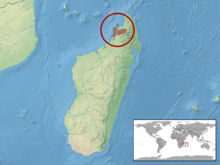Brookesia minima
| Brookesia minima | |
|---|---|
| Scientific classification | |
| Kingdom: | Animalia |
| Phylum: | Chordata |
| Class: | Reptilia |
| Order: | Squamata |
| Suborder: | Iguania |
| Family: | Chamaeleonidae |
| Genus: | Brookesia |
| Species: | B. minima |
| Binomial name | |
|
Brookesia minima Boettger, 1893 |
|
 |
|
Brookesia minima, (common names of which include the dwarf chameleon, the Madagascan dwarf chameleon, the minute leaf chameleon, the Nosy Be pygmy leaf chameleon, and the tiny ground chameleon, is a diminutive chameleon that was regarded as the smallest lizard of the Chamaeleonidae until a smaller species, B. micra, was described in 2012.
B. minima is endemic to Nosy Be, an island located just off the northwest coast of Madagascar, but has extralimital distribution to Manongarivo Reserve on Madagascar's northwest coast.
B. minima is the second-smallest lizard ever described. The species has the independently rotating eyes and prehensile tail characteristic of all chameleons. It is coloured light grey on the head, back and tail, although the tail becomes orange then yellowish towards the tip. The sides of the body are brown, occasionally interrupted by dark brown spots, and the limbs are almost entirely dark brown. Spotted patterning appears to be a stress colouration, and unstressed individuals have a more or less uniform dark brown body, apart from a beige area in front of the eyes (1). The B. minima adult has a flattened head and an orbital crest with large scales forming triangular plates above its eyes. Along its back are two rows of granular protrusions. B. minima specimens sometimes have lateral yellow stripes over their basic drab grayish-brown color. The maximum total length is 3.4 cm (1.3 in) for females and 2.8 cm (1.1 in) for males. Males are also more slender than females, and exhibit a hemipenial bulge at the base of their tails.
B. minima is native to the rain forests of its native island. It has a relatively active habit for a chameleon and likes moving around in the low branches and leaf litter of its native rain forests. Though they are moderately aggressive toward one another, population and densities in the wild may approach one animal per square meter.
...
Wikipedia

